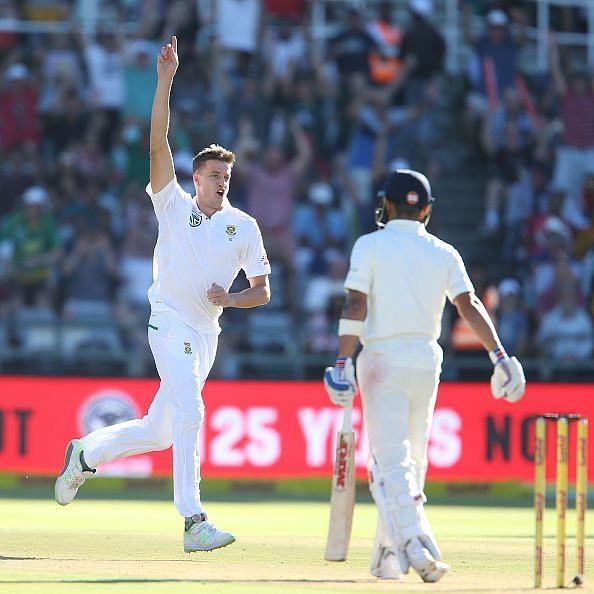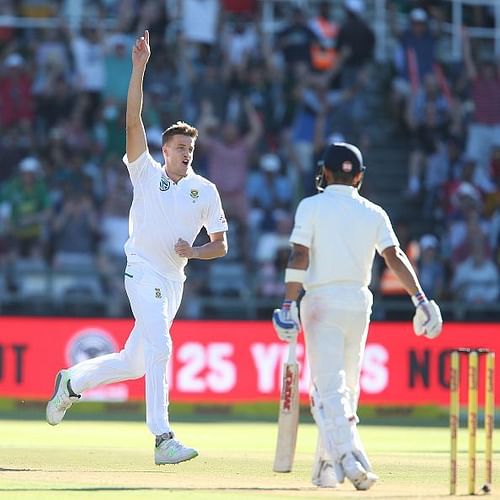
India’s overseas reality check: Lions at home and lambs overseas

Virat Kohli and Ravi Shastri take their places in front of the press. The duo seemingly have a fantastic working relationship. They had worked extremely well together in their previous stint and now were on the verge of making their partnership all the more fruitful. As a matter of fact, it was Kohli who had requested the presence of Shastri following the spiteful controversy that removed Anil Kumble from the helm.
Taking their seats in front of a bevvy of reporters, Kohli and Shastri seem ready. As ready as they were for their tour of South Africa. Of course, they were ready. Why would they not be? The Indian team’s dominance at home was extraordinary, to say the least. Wins over South Africa, New Zealand, England, and Sri Lanka had capped off what were amazing tours to the West Indies and Sri Lanka as well. Their impressive showing in the Champions Trophy, despite conceding the title to Pakistan, added to their confidence.
Both Shastri and Kohli seemed unruffled as they went about taking questions prior to their departure. They had done several press conferences before this and this was not something new. Yet, the tone of the reporters was rather ominous. They too had good reason though to be worried about the team. They had watched Indian teams tour the country since 1992 and most touring parties if not all had come back empty-handed.
Of course, it was far from an easy place to tour. Shastri had mentioned it himself when he said, “There would be no joy to the cricketing job should these players not face challenges as they were.” A week and a half passed and the Indian side found themselves in South Africa. It seemed as though with every passing day, the general public's confidence in the Indian team was growing. It seemed as though Kohli and his band of merry men would surely bring home the holy grail from South Africa this time around.
A few days later, Kohli found himself in a precarious position. He walked out of the dressing room in the Newlands Stadium set to face the music. The same unrelenting music that Shikhar Dhawan had faced. Dhawan was on the way to the pavilion to put on his leg warmers. Kohli, on the other hand, had to enter the cauldron.
Ottis Gibson had relieved Charl Langeveldt as bowling coach just before the series began. He now had a couple of hats when it came to the South African backroom. He was no stranger to the land. He had been part of a few domestic sides and knew the conditions well. His first move was to reinstate Dale Steyn into the starting XI. The 34-year-old Steyn did not have the fiery pace he once did. However, much like Dennis Lillee, Steyn was as menacing as he was in his younger days. Gibson, with his wealth of knowledge, knew this.
Morne Morkel, Kagiso Rabada, and Vernon Philander would complete the attack. They played an additional bowler. In the grand scheme of things, it seemed a good ploy. Especially given the fact that they had clawed their way to 286 in the first innings against a world-class bowling attack. The Indians were on the back foot, right away.
Steyn to Kohli. This was an interesting contest. They had played against each other several times in the past. They did respect each other a great deal, but it was war, and neither of them was willing to back away. The first delivery. A hint of in-swing caught Kohli napping as he almost chipped it straight back to Steyn. The latter knew he was onto something.
Kohli, all things said, realized something. He was not in the subcontinent anymore. Marais Erasmus, seated in the embers of the crowd, also sensed the same. He had been part of many an Indian victory over the last year or so. While watching Kohli shuffle hurriedly, he perhaps murmured to himself, “Welcome to the real world son.”
Kohli would face Steyn and then Morne Morkel. Despite his twin double centuries in the fall of 2017, the Indian skipper’s off-stump weakness had seemingly not been exploited enough. Morkel finally put an end to his misery and Quinton de Kock kindly accepted the catch. Perhaps it was Morkel’s way of reviving the age-old Joe Garner ploy. “Attack the captain and get him out as soon as possible and the team will crumble around him.”
Interestingly, the team did indeed begin to crumble. Wickets fell in tandem and the Proteas pace battery simply kept coming. Even Cheteshwar Pujara, after a long struggle at the centre, was dismissed shortly after tea on the second day.
This batting performance, while not as poor as one may have expected, thanks to Hardik Pandya's heroics, brings back memories from the Indian tour of 1996. The first Test at Kingsmead saw the Indians polished off for 100 and 66 in the first and second innings respectively.
A newsflash read that the Indians would remain the top Test nation in the world should they find themselves on the wrong end of the spectrum against the Proteas. One may even go as far as to question the incentive for the Indians to perform well in overseas conditions this year. A tour to England beckons soon after the South African engagement and the pressure will certainly be on Virat Kohli and his side. At least should they continue performing this way.
The sceptics who challenge Kohli including myself are indeed fearful of the Indian chances in conditions that do not suit them. However, the same sceptics who do indeed go the extra mile to criticise the captain and his methods are also the first ones to admit we were wrong to do so.
Yet, as things stand, it certainly is an uphill battle for Kohli to ensure that his Indian side change the narrative of ‘Lions at home; and Lambs overseas’.